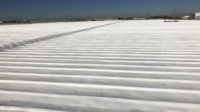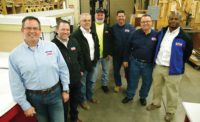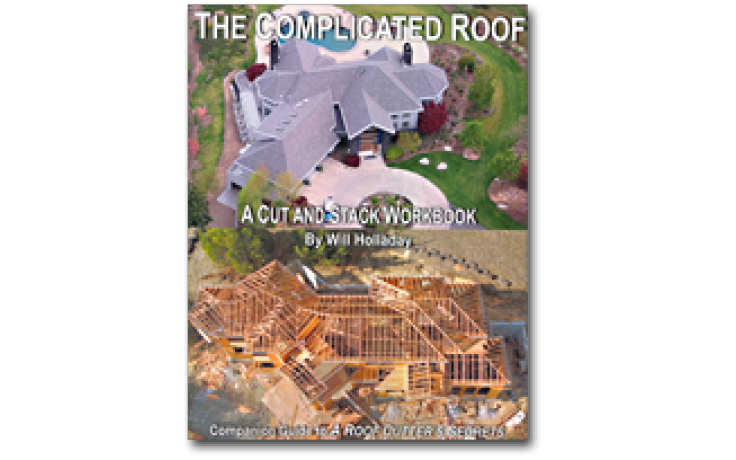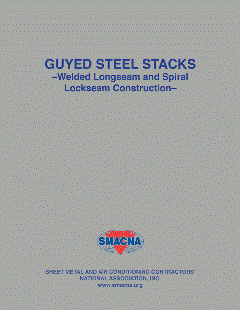Case Study: Reroofing at Georgia Schools Completed as Classes Continue
Conquering Rome One Roof at a Time

The Rome Schools reroofing project was among the largest ever worked on by Ben Hill Roofing Inc., of Douglasville, Ga., and completed while classes remained in session. Photos by Rick Damato

Crews from Ben Hill Roofing reroofed roughly 3,000 squares of metal standing-seam steel panels at the Rome Middle and High School campus in Rome, Ga.

The Rome Schools reroofing project was among the largest ever worked on by Ben Hill Roofing Inc., of Douglasville, Ga., and completed while classes remained in session.
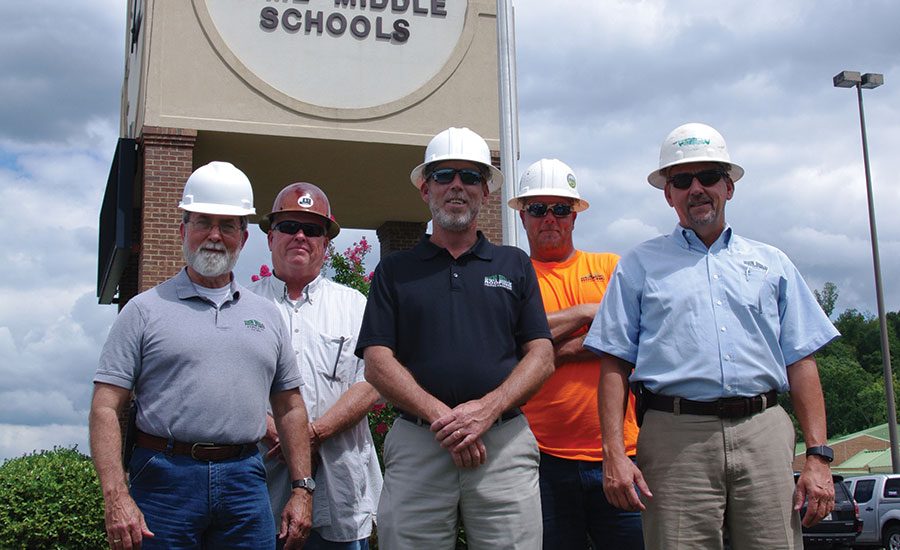
(From left) Johnny Rogers, project manager of Ben Hill Roofing; Joe Wade, superintendent, J&R Construction; Roger Gray, general production manager; Jake Balcombe, superintendent; and David Welch, president at Ben Hill Roofing, were onsite for the completion of the Rome Schools roofing project last year.
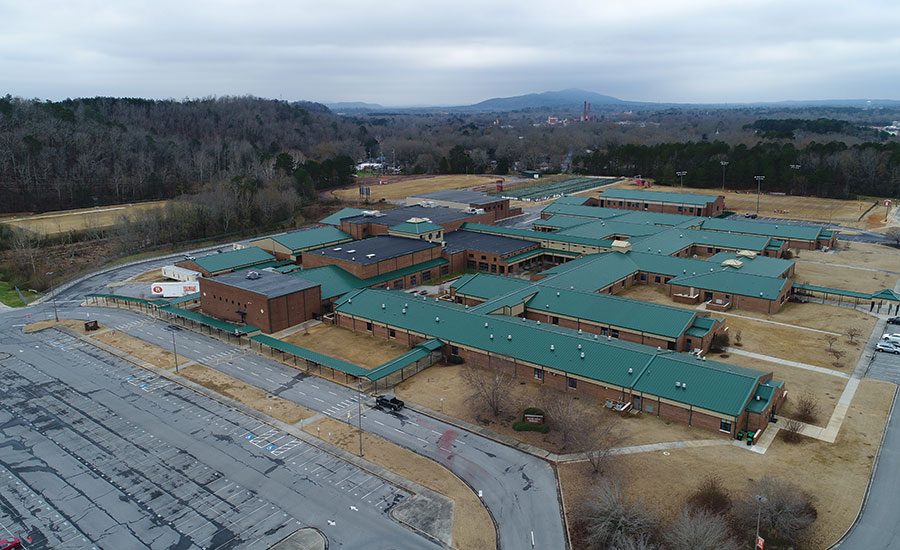
The Rome Schools reroofing project was among the largest ever worked on by Ben Hill Roofing Inc., of Douglasville, Ga., and completed while classes remained in session.





The axiom, “Rome was not built in one day,” stems from a French proverb dating back to the end of the 12th century. Roofing and building contractors understand this concept, which means simply that large and important projects take time.
Despite this, building-owner demands may outweigh even proverbial truths. Sometimes, there is simply not enough time in the budget to build Rome. Such was the case when Ben Hill Roofing was chosen to retrofit the roofs of Rome — Rome (Georgia) High School and Rome Middle School, that is.
Built in the mid-1990’s, Rome’s high and middle schools were showing their age. The bloom was gone from the green standing seam metal roofs and there were leaks that were irritating to school officials on many levels, not the least of which was collateral damage to the building interiors and the cost of ongoing repairs. But replacing the thousands of squares of roofing would not be easy or inexpensive.
The retrofit solution had to consider all the factors that would matter when reroofing any active educational facility. Things that are not welcome in any working school environment including noise, offensive odors, dust, and especially leaks caused by construction activities. What Rome City Schools officials did want included a beautiful new roof, and a 20-year “no dollar limit” warranty.
The best time to perform any significant work on a school building is when school is out, but that was not possible in the case of the first and largest of the two projects, Rome High School. Special considerations were made in the staging of all work and in the jobsite safety analysis.
The task of designing a solution fell to the original architects of the structures, Southern A&E LLC of Austell, Ga. The firm works in the areas of commercial, industrial, educational and athletic facilities. The contract for the project, which also included plumbing, HVAC, painting and some additions, was given to J&R Construction & Development Inc. of Carrolton, Ga. The successful roofing bidder for both projects was Ben Hill Roofing Inc. of Douglasville, Ga.
Public roofing projects of this size and scope typically attract a lot of attention from manufacturers and contractors alike. In this case around 3,000 squares. When the dust cleared after the many proposals and counter-proposals, the project was awarded to Ben Hill to install a Sika Sarnafil Décor Roof System.
The Battle Plan
The two school roofs were retrofitted under different contracts beginning with Rome High School. This project included recovering the roughly 2,000 squares of roofing along with the other improvements. The scale of this reroof demanded a roofing contractor with considerable resources and experience. According to Ben Hill Roofing’s Owner David Welch, the high school project was the fourth-largest ever taken on by the firm.
Reroofing by removing and replacing the metal roofing system was not feasible considering the amount of disruption that would be caused by the demolition. Large portions of the school would have to be closed to accomplish a roof replacement. The aesthetics of the buildings, however, demanded that the look of the standing-seam roofs remain essentially the same.
The existing buildings were clad with 2” high by 16” wide single-lock standing-seam painted steel panels. In addition to the leaks, the once beautiful green roof looked pale and dated.
“It was just time,” said Tim Williams, maintenance director for Rome City Schools who oversaw these projects, of the decision to replace the roofs. Now COO of the Rome City Schools, Williams did considerable due-diligence on all options for this roof replacement.
In the end, the decision to recover the metal roofs with the Sarnafil Décor system came down to three key factors: Protection of the buildings and their inhabitants during construction; adding more insulation (without removing any of the existing); and the time it took to complete construction. Attempting to repair, remediate, or remove and replace the metal roofs would have either taken too much time, been cost-prohibitive, would have been too disruptive, and wouldn’t have achieved the 20-year warranty desired.
In a perfect world, all the construction and roof replacement would’ve taken place when school was out, eliminating many safety concerns for the students and teachers as well as the roofers on site. It was not to be as work on the Rome City High School reroof started a few days before the new school year began.
The replacement system consisted of 2” polyisocyanurate roof insulation formed in panels scored to break into 16” wide strips to fit between the standing seams. Above that a layer of ½” high-density ISO coverboard was mechanically fastened. The original specifications were to also mechanically fasten the 60-mil membrane, but this was changed to an adhesive-applied feltbacked membrane for superior aesthetics.
The specifications further called for the replacement of all exposed metal flashings as well as all gutter and downspouts. The metal was ordered with a custom color to match the green Sarnafil PVC membrane. All the metal was fabricated by Metal Pride Inc. of Atlanta, and there were literally miles of metal building components on these two school roofs combined.
Training the Troops
As is typical when a contract for roofing work calls for a 20-year “no-dollar limit” warranty, there are a lot of boxes to check. The contractor must be credentialed and approved by the manufacturer; the specification must be agreed upon; all other details related to the finished systems such as fastener patterns, metal flashing components furnished by others, and pacing of the project. Then there are the legal and bonding and insurance considerations. In addition to all of this, Sika Sarnafil conducted training for crews and crew leaders in advance of and at the beginning of the project at the request of Ben Hill Roofing.
The Sika Sarnafil representative on the Rome City Schools projects was Michael Rauth. With a background in mechanical engineering and experience working with a roof-consulting firm and roofing manufacturer, Rauth has been in roofing since the early 1990’s. Training with Ben Hill Roofing’s crews in the shop was conducted by Sika Sarnafil’s inspector, Perry Thomas, before any of the work began.
Pre-job training takes a half to a full day and includes best practices for heat welding membranes, flashings, and Décor ribs, proper handling of handheld and robotic welding machines, and sample check/quality control procedures. When the work began, Sika Sarnafil conducted another training session on the roof. Routine inspections by the manufacturer are conducted on warranty jobs so the training continued as needed. But the Ben Hill Roofing crews, led by Jake Balcombe on the high school and Gustavo Melchor on the middle school, were consistent in their installation practices as evidenced by the awarding of the warranty on each project.
And training was key to the successful completion of this project. Figuring out how to properly and productively weld the Décor ribs turned out to be the “secret sauce” for bringing the project in on budget and in time.
As part of any Ben Hill Roofing project, safety is a key component of all worker training. In addition to safety training routinely given to all Ben Hill roofers, a safety meeting was conducted every Monday morning of the project. Topics for the safety meetings included proper installation and use of full fall-arrest systems, operation of the telescopic lifts, ladder safety, and general housekeeping. Daily safety briefings were also held before the start of each work day.
Hand-to-Hand Combat
Since these projects were conducted during school hours there were numerous other special safety requirements including the restriction of all hoisting operations to before 7:30 a.m. or after 4:30 p.m. Special precautions were put into place to keep eyes on ladders anytime students, who can be “curious onlookers,” were present. Materials loaded on the site were stored in tight areas away from foot traffic.
In the few opportune days Ben Hill Roofing had to work before the school year began, they hit the ground running with up to 63 roofers. Once school was in and the project got rolling the teams were down to 30 or less. Roger Gray, Ben Hill Roofing’s general manager, was very conscious of the possibility of safety or production issues on these projects, but said they never materialized.
Equipping the Troops
Rome High School and Middle School are on the same campus separated by a large parking lot, which was good for staging materials and storing equipment as could be allowed. Accessing the roofs was, for most of the project, easy enough with most of the buildings being one story. Even the taller structures were accessible with telescopic lifts.
The workhorse on these projects were the Sarnamatic 661 hot air welding machines furnished by Sika Sarnafil. The Sarnamatic was used to weld all of the seams as well as the Décor ribs. The membrane sheets were 6 ½’ wide and a rib covered every seam with an additional three ribs in the field. The ribs stand 1 ½” tall and are ½” wide, simulating the look of the standing seam roofing that was being covered.
A special adaptor is used on the Sarnamatic welder to apply the ribs to the membrane. Having the ribs heat welded was key to the decision to choose this system. Having the ribs applied with an adhesive or with a self-adhered strip was considered unsuitable.
Leading the Charge
The Rome High School and Middle School projects included not only roofing but many other improvements, such as electrical, plumbing, HVAC, cleaning and painting. The general contractor for both projects was J&R Construction of Carrolton, Ga. Steve Baird was J&R’s VP/project manager and Joe Wade served as the project superintendent. Asked about the successes and challenges on the project, Baird said, “I think the best thing was not tearing off… all work could go on while the campus was occupied.” He added, speaking of working with Ben Hill Roofing, Baird said, “It was great; hands-free.”
Rome City Schools’ Williams had nothing but good things to say about the performance of Ben Hill Roofing, with comments like, “Excellent to work with,” and “No complaints at all.” And of the Sika Sarnafil Décor recovery system, Williams added, “I think you’re going to see more and more of it.”
Peace in the Valley
Rome, Ga., has a most interesting history. Situated in the Coosa Valley at the confluence of three rivers, it has been a strategic location dating back to the days when the Creek and Cherokee people occupied the area. While those days when Native Americans were forced to move west by the emerging European settlers were far from peaceful, there is peace in this valley today. And for two Rome City schools there’s peace on their roofs, owing to a beautiful new look and freedom from leaks underneath.
Looking for a reprint of this article?
From high-res PDFs to custom plaques, order your copy today!




